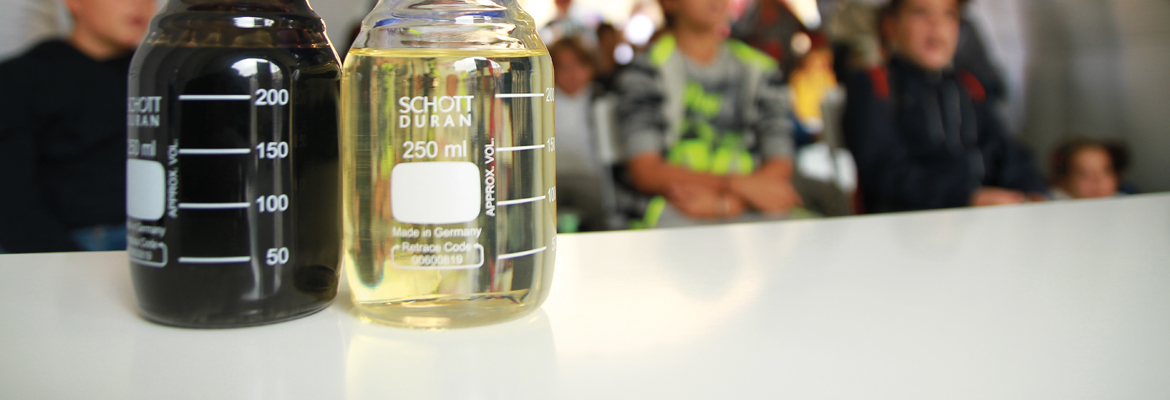Changing often means evolving, keeping up with the times. What seemed to be a pioneering activity more than thirty years ago, when the Mandatory Consortium for Used Oils (Consorzio Obbligatorio Oli Usati, COOU) was created, now has become a reality. Indeed, over the last three decades, waste has finally become a resource, as proved by the very COOU data.
In 2015, according to the latest COOU’s Green Economy Report, the system’s businesses collected about 166,700 tonnes of used oils, which is almost 43% of the total volume of oil consumption during the same year. Such a percentage nearly equals the maximum hypothetically achievable limit, if we consider that more than half the lubricants are consumed during their use.
Collected oils were destined to regeneration aimed at material recovery in 99.7% of cases, which amounts to 165,500 tonnes, and only 465 residual tonnes were incinerated.
This most important datum, equalling almost 100%, shows an ongoing trend for various years now.
“This was made possible – as we can read in the latest COOU’s Green Economy Report – by the regeneration businesses’ investments in pre-treating processes for the oils entering refineries. This means that, without posing risks to the environment, the share of collected used oils classified as eligible to be recovered as fuel for energy production can be absorbed through the re-refining process, thus making an exception to the technical regulations on used oils’ handling.”
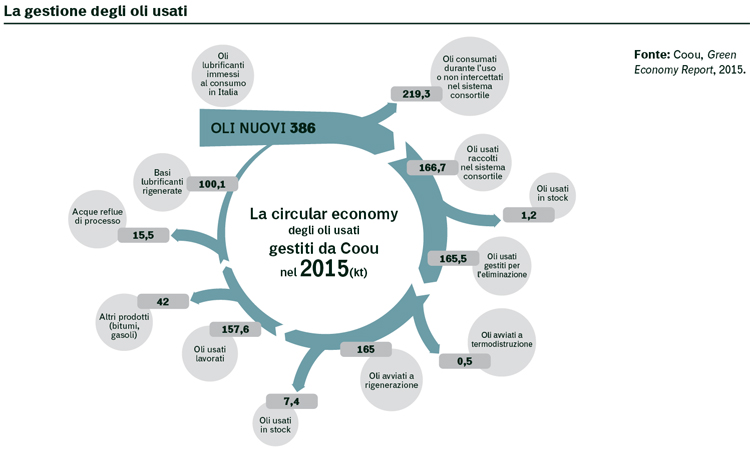
However, not only have the businesses improved their performance, but also the COOU has changed its managing model. Since mid-2014, its role as market operator trading used oils with collecting and regenerating businesses was redefined to become that of a subsidiary operator. Thus, the COOU continues to guarantee and promote collection, but it allows the operators the freedom to negotiate prices for trading used oils destined to regeneration.
The COOU explains that “the subsidiary role defined within this change is maintained as a guarantee against a prospective ‘market failure’, namely in case that the management of used oils destined to regeneration proved uneconomical for businesses in this field – for instance due to the petroleum price volatility – risking that the hazardous waste management is dangerous for the environment.”
From an operational point of view, according to the old model, the COOU had a service contract with authorized collecting businesses which took care of used oils all over Italy at no extra cost for their owners. In order to avoid any risk linked to waste transfer, collected used oils were gathered in storage facilities coordinated by the Consortium and distributed to regenerating businesses or in nearby areas. With the aim of guaranteeing a fair treatment, the costs of transfers from the collecting businesses’ temporary storage tanks to the storage facilities were paid by the COOU. Subsequently, oils were analysed and classified according to the most suitable methods of treatment.
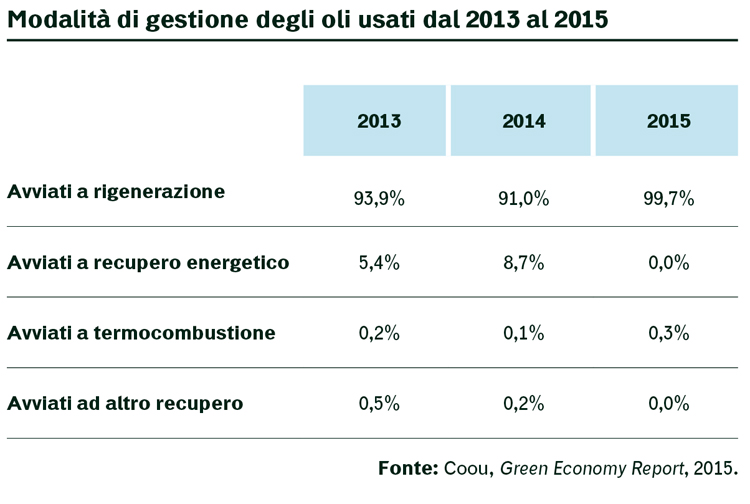
With its new management model, the COOU has eased direct relationships between collecting and regenerating businesses by modifying its contract agreements with collecting businesses and proposing two different types of contracts.
The first states that the COOU must give collectors an incentive to collection – including micro-collection – as well as further rewards and reimbursements, whether the collected used oils are transferred to the Consortium or directly to a refinery.
The second, instead, sets a price for the purchase of used oils in the last resort. It is a tool allowing collecting businesses to hand over used oils to the Consortium at a fair price, should they not manage to sell them at an acceptable price through direct negotiations with regenerating businesses.
Lastly, according to the new model, the COOU maintains its role as a coordinator of storage centres, through which it is able to check the flows and quality of collected used oils in order to classify them before being sold to regenerating businesses.
After this examination, used oils can therefore be traded freely among businesses, while “last resort” oils, namely those bought at a fixed price by the COOU itself, are shared out to regenerating businesses via managed distribution or tender.
However, changes do not always guarantee immediate success. Sometimes, it takes months, if not years, to see the first positive results. This is not the case: the metamorphosis of the COOU’s system has reinforced the collection and reuse trends from the previous years. Not only has the maximum theoretically possible collection limit been almost achieved, but also the percentage of oils destined to regeneration has nearly reached 100%, an unprecedented result.
“This collection performance – as we can read in the Green Economy Report – is confirmed in the first six months of management of the new operational model as well as throughout 2014 and 2015 as well when the used oils’ trade within the supply chain was carried out mainly through direct agreements between collecting and regenerating businesses. This is a clear sign that the system of Italian businesses in the used oils’ supply chain managed to respond positively to the change of operational model introduced by the COOU.” Another important sign, which needs to be noted and interpreted, is represented by the performances relating to the flow and quality checks of collected used lubricant oils. In this case as well, no considerable difference has been noticed between the two management models, which proves that the supply chain was ready for the leap.
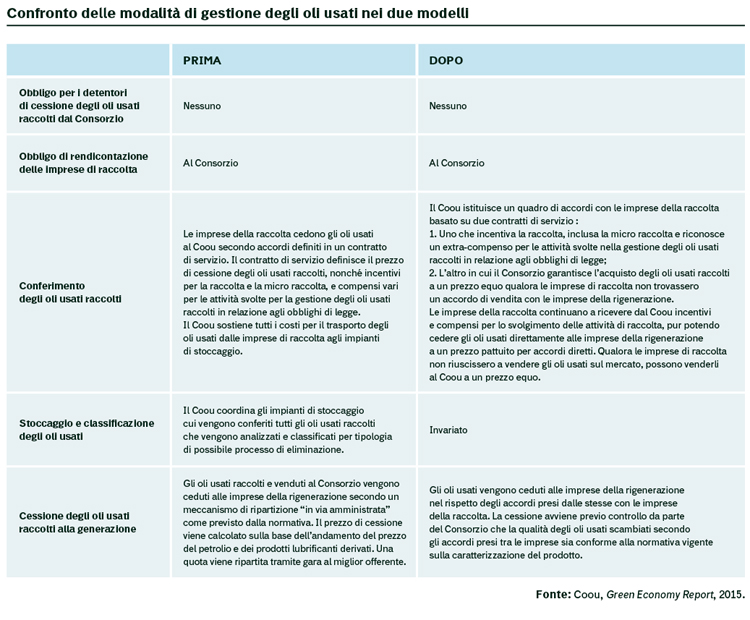
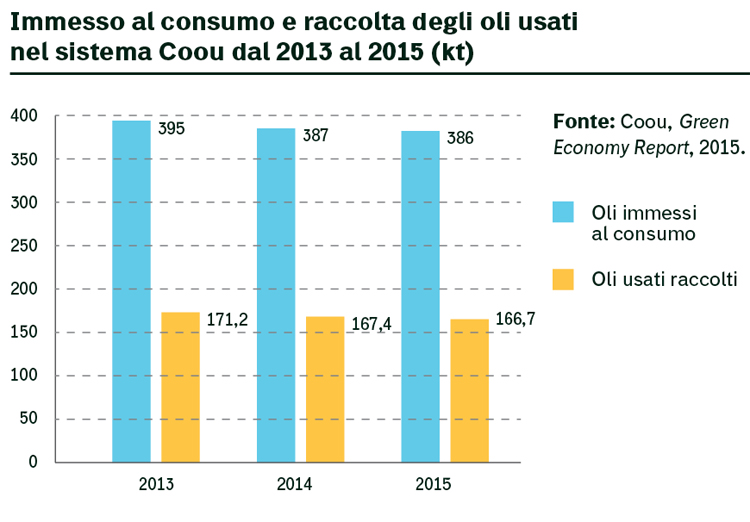
Indeed, this journey lasted for years, as shown by the achievements in regenerating an ever-growing quantity of oils. Over the years, the performance was uneven, showing both positive and negative trends as well – at least until the beginning of the 2000’s – which then reverted to positive and improved in the last three years of management.
As the Green Economy Report 2015 explains in full details, “the quantity of oils destined to regeneration increased in the last few years because, unlike what happened in the past, a considerable amount of collected used oils classified as eligible to incineration with energy recovery by the COOU were, instead, acquired by regenerating businesses. The latter are authorized to treat these oils as an exception to the technical regulations on used oils’ management, defined by Ministerial Decree 1996, n. 392. ‘Regulation laying down technical rules relating to used oils’ destruction,’ as stated in article 216 a, paragraph 7 of Decree Law 152/2006 and subsequent supplements.”
However, the Report does not fail to stress that such a transition, which represented a real opportunity, was brought about by the system’s regenerating businesses before the Consortium’s new management model became effective. They contributed “in a positive way to the cycle of mineral oils used following the circular economy’s perspective, all the more so as it was a period of decline in used oils’ availability, because of the structural decrease in lubricants’ consumption.”
In other words, regenerating businesses were able to invest in innovation, by adapting their storage and treatment facilities for incoming used oils to the preflash process. Therefore, they made it possible to recover materials – including used oils classified as “eligible to incineration” – avoiding risks to the environment, “without compromising the regeneration’s final result, whose percentage is maintained around 65% of the processed used oils, and increasing the overall amount of regenerated base oils produced.”
Info



